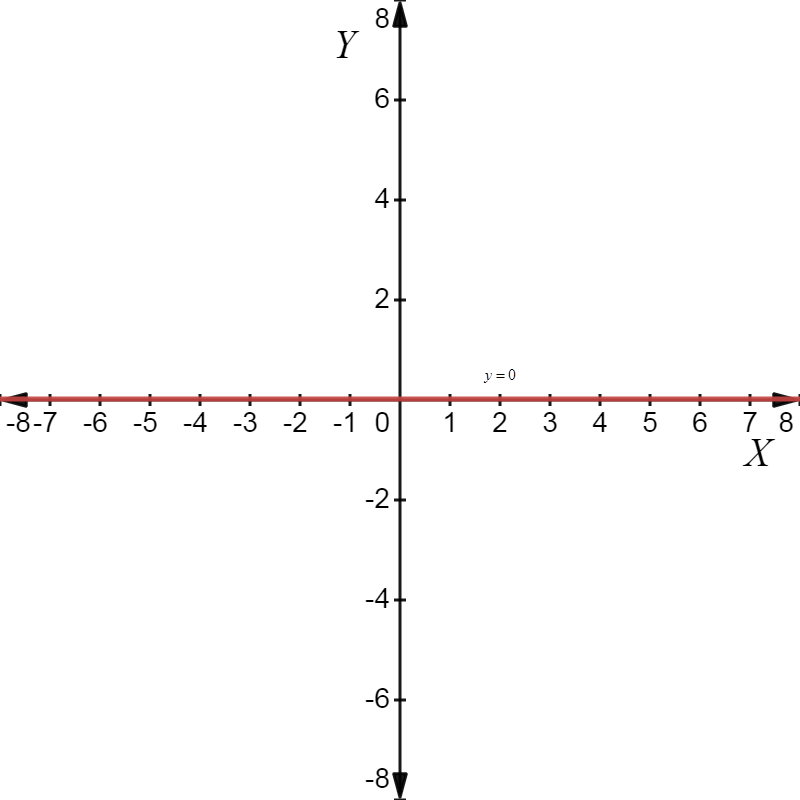
Draw the graph of the following:
i) \[y = 0\]
ii) \[x = 5\]
iii) \[x = - 7\]
iv) \[y = 4\]
v) \[y = - 3\]
Answer
413.4k+ views
Hint: In the given question, we need to understand that the given equations are either of the form\[x = a\]or\[y = b\]. It represents a straight line parallel to\[y - axis\]in case of\[x = a\]and parallel to\[x - axis\]in case of\[y = b\]. So, we will draw them on a Cartesian plane.
The linear equation in one variable represents a point on a number line, a line on a Cartesian plane, and a plane on a three-dimensional plane.
Complete step by step answer:
i) \[y = 0\]
This means that for every value of\[x\], would always be equal to zero.

ii) \[x = 5\]
This means that the representing\[x = 5\] passes through point\[\left( {5,0} \right)\]. So, we will draw the line parallel to\[y - axis\]and pass through\[\left( {5,0} \right)\].

iii) \[x = - 7\]
This means that the straight line representing\[x = - 7\] passes through point\[\left( { - 7,0} \right)\]. So, we will draw the line parallel to\[y - axis\]and passing through\[\left( { - 7,0} \right)\]

iv) \[y = 4\]
This means that the line representing\[y = 4\] passes through point\[\left( {0,4} \right)\]. So, we will draw the line parallel to\[x - axis\]and passing through\[\left( {0,4} \right)\]

v) \[y = - 3\]
This means that the line representing\[y = - 3\] passes through point\[\left( {0, - 3} \right)\]. So, we will draw the line parallel to\[x - axis\]and pass through\[\left( {0, - 3} \right)\].

Note: The linear equation in one variable is an equation which can be expressed in the form of \[ax + b = 0\], where \[a\]and \[b\]are two integers, and \[x\] is a variable and has a unique solution. To Graph the linear equations in one variable, firstly, find the \[x\]-intercept. Then plot the line which is either parallel to\[x\] axis or \[y\] axis and cutting the coordinate axis at\[\left( { \pm a,0} \right),\left( {0, \pm b} \right)\].
The linear equation in one variable represents a point on a number line, a line on a Cartesian plane, and a plane on a three-dimensional plane.
Complete step by step answer:
i) \[y = 0\]
This means that for every value of\[x\], would always be equal to zero.

ii) \[x = 5\]
This means that the representing\[x = 5\] passes through point\[\left( {5,0} \right)\]. So, we will draw the line parallel to\[y - axis\]and pass through\[\left( {5,0} \right)\].

iii) \[x = - 7\]
This means that the straight line representing\[x = - 7\] passes through point\[\left( { - 7,0} \right)\]. So, we will draw the line parallel to\[y - axis\]and passing through\[\left( { - 7,0} \right)\]

iv) \[y = 4\]
This means that the line representing\[y = 4\] passes through point\[\left( {0,4} \right)\]. So, we will draw the line parallel to\[x - axis\]and passing through\[\left( {0,4} \right)\]

v) \[y = - 3\]
This means that the line representing\[y = - 3\] passes through point\[\left( {0, - 3} \right)\]. So, we will draw the line parallel to\[x - axis\]and pass through\[\left( {0, - 3} \right)\].

Note: The linear equation in one variable is an equation which can be expressed in the form of \[ax + b = 0\], where \[a\]and \[b\]are two integers, and \[x\] is a variable and has a unique solution. To Graph the linear equations in one variable, firstly, find the \[x\]-intercept. Then plot the line which is either parallel to\[x\] axis or \[y\] axis and cutting the coordinate axis at\[\left( { \pm a,0} \right),\left( {0, \pm b} \right)\].
Recently Updated Pages
Master Class 11 Accountancy: Engaging Questions & Answers for Success

Express the following as a fraction and simplify a class 7 maths CBSE

The length and width of a rectangle are in ratio of class 7 maths CBSE

The ratio of the income to the expenditure of a family class 7 maths CBSE

How do you write 025 million in scientific notatio class 7 maths CBSE

How do you convert 295 meters per second to kilometers class 7 maths CBSE

Trending doubts
When people say No pun intended what does that mea class 8 english CBSE

How many ounces are in 500 mL class 8 maths CBSE

In Indian rupees 1 trillion is equal to how many c class 8 maths CBSE

Which king started the organization of the Kumbh fair class 8 social science CBSE

What is BLO What is the full form of BLO class 8 social science CBSE

Advantages and disadvantages of science




